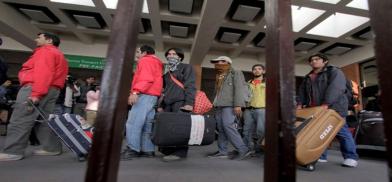Worker-sending countries like Nepal brace for migrant crisis
Tens of millions of migrant workers, forced to return home in the wake of the COVID-19 pandemic after turning jobless in countries of destinations, face unemployment and poverty in their home countries, the International Labour Organisation has warned

Kathmandu: Tens of millions of migrant workers, forced to return home in the wake of the COVID-19 pandemic after turning jobless in countries of destinations, face unemployment and poverty in their home countries, the International Labour Organisation has warned.
Globally, migrant workers are among the hardest hit by the COVID-19 pandemic. With the relaxation of coronavirus containment measures, millions of migrant workers are expected to return home to low and middle-income countries like Nepal, where labour markets, which were already fragile before COVID-19, are now further weakened by the additional strain of high levels of unemployment and severe business disruptions due to the pandemic.
Families dependent upon the remittance sent by the migrant workers will suffer financially from the loss of the remittance, according to the International Labour Organisation (ILO).
“This is a potential crisis within a crisis,” said Manuela Tomei, director of the ILO’s Conditions of Work and Equality Department, in ILO’s statement released on Wednesday. “We know that many millions of migrant workers, who were under lockdown in their countries of work, have lost their jobs and are now expected to return home to countries that are already grappling with weak economies and rising unemployment. Cooperation and planning are key to avert a worse crisis.”
It is estimated there are 164 million migrant workers worldwide, nearly half of them women, comprising 4.7 per cent of the global labour force. While not all of these workers will return home–after losing their jobs or for other reasons–preliminary ILO research in more than 20 countries indicates that many millions are expected to do so.
A large number of migrant workers have remained stranded in host countries without access to social protection and little money for food or accommodation. Even those with jobs are compelled to receive reduced wages and are living in cramped workplaces and residences where social distancing is impossible, putting them at higher risk of contracting the virus, the labour rights group said.
Nepal, a major labour supplying country in the South Asia region and recipient of billions of rupees as remittance, is grappling with the COVID-19 pandemic at home, and at the same time, it is struggling to evacuate Nepali migrant workers from COVID-19-hit labour destination countries.
Nepali migrant workers in Persian Gulf countries, Malaysia and South Korea have been affected due to COVID-19 in the form of job loss and wage cut and they continue to live under the fear of coronavirus infections.
As per the initial government estimates, nearly 25,000 Nepali migrant workers require urgent repatriation in the first phase.
Since the outbreak began, a crisis was in the making for Nepal, the 19th biggest remittance receiver in the world. With the stoppage in labour migration, which would decrease the inflow of remittance, it also invited the daunting task of not only repatriating Nepali workers but also providing them with opportunities.
“This crisis is particularly critical for poor countries like Nepal, where the state has poorly responded to the public health crisis and the economic fallout. This pandemic is not only exacerbating the existing economic and public health problems but also creating new forms of livelihood crisis,” Ramesh Sunam, a migration researcher and author, whose book ‘The Remittance Villages’ was recently published, told the Post from Japan in an email interview.
“As a result, the crisis looms large for both migrants and migrant families, particularly for those having little engagement in farming and relying entirely on remittance incomes for their livelihoods,” said Sunam.
According to Sunam, the ongoing crisis will end up leaving many poor migrant families further indebted due to their failure to pay back loans taken for financing their migration, leading them to face a severe livelihood crisis.
The ILO has pointed out that worker-sending countries have very limited scope to reintegrate such large numbers of people, and often do not have policies and systems in place to ensure effective labour migration governance and smooth reintegration plans, including for skills development and recognition.
Governments in Asia and Africa, in particular, expect millions of migrant workers to return, whether through compulsion or voluntarily, as their job prospects evaporate, states the ILO.
The number of Nepali migrant workers to return home from the Persian Gulf countries and Malaysia—which remain Nepal’s most preferred labour destination countries—vary and is estimated to be around nearly half a million in the long run.
The Nepal government has said that returnee workers would be provided jobs inside the country and have rolled out ambitious plans to generate massive opportunities inside the country—a herculean task as called by experts looking at the high number of returnee workers.
“The government seems to be concerned about returned migrant workers, but the way it is moving ahead is disappointing,” said Sunam, who is also an assistant professor at Waseda University in Tokyo. “What we need now is more consultation, more coordination and more dialogue with regards to developing new policies rather than working in silos. The government is minimally prepared to retain the returnee migrant workers.”
The ILO briefing and policy documents focusing on the effects of the COVID-19 pandemic on migrant workers, refugees, or forcibly displaced persons, expresses concerns over the potentially serious social and economic impact if returns occur over a short period of time and if migrants are not included in social protection measures or given help to reintegrate into national labour markets.
The research also highlights how returnee migrant workers bring skills and talent that can help their home economies rebuild better after the pandemic. But the key to unlocking this potential is the establishment of rights-based and orderly return and reintegration systems, access to social protection, and proper skills recognition, the ILO has urged, which can facilitate better skills and jobs matching, so increasing productivity for national industries.
In addition, helping returning migrants reintegrate could reduce tensions in their home countries, where some communities may fear that returning migrants may bring the virus or take jobs away.
“With the right policies, the return of these workers can be converted into a resource for recovery,” said Michelle Leighton, chief of the ILO’s Labour migration department. “These migrants will bring with them talents and new skills, and in some cases, capital that can support efforts in their home countries to build back better.”
According to Sunam, the Nepal government could develop policies for transforming agriculture in terms of providing returnee migrants with beneficial access to land and interest-free credit or soft loan in addition to changing sharecropping rules and fixed-rent tenancy to benefit the actual farmers, not the landlords.
“The government could provide incentives for establishing and running agricultural and non-agricultural enterprises while relaxing unnecessary bureaucratic procedures,” said Sunam. “But no transformative social and economic policies are in the offing to address the crisis. Given the weak state institutions and rampant corruption even during this crisis, people are largely left on their own to cope with the crisis.”
https://kathmandupost.com/national/2020/06/25/worker-sending-countries-like-nepal-brace-for-migrant-crisis-within-COVID-19-crisis-ilo-warns









Post a Comment